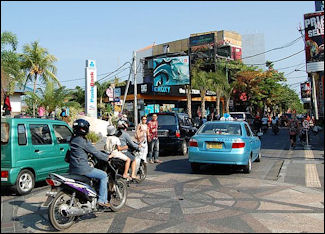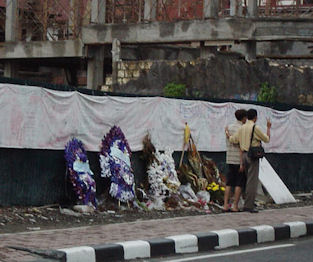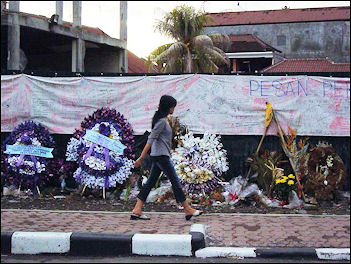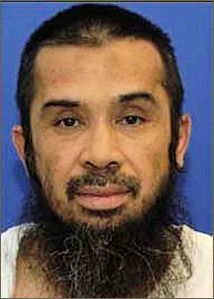BALI BOMBING IN 2002

Bali bombing site October 12, 2002 a bombing on the Indonesian holiday island of Bali killed 202 people, 88 of them Australians, and injured more than 160, many of them suffering from terrible burns. The attack took place at Kuta Beach, a popular resort with foreign tourist in Bali. It was the worst terrorist attack since the September 11th attacks and brought Indonesia to the forefront of the war on terrorism. The attacks are carried out by Jemaah Islamiyah, a South-east Asian extremist group inspired by Al Qaida.
Denny Lee wrote in the New York Times: “The attacks occurred just after 11pm on Oct. 12, 2002, a busy Saturday night. A bomb linked to Al Qaeda ripped through Paddy's Bar, a popular nightclub on Legian Street, in the bopping tourist district of Kuta. The location was no accident. It was as if the blast tore through the Ramblas in Barcelona or Times Square in New York. “Half a minute later, a more powerful car bomb exploded across the street, creating a three-foot-deep crater outside the Sari Club and trapping hundreds in a disco inferno. Many of the dead -- including 88 Australians, 38 Indonesians, 26 Britons and 7 Americans -- had been fleeing the first blast. The Balinese call it their ground zero.” [Source: Denny Lee, New York Times, March 27, 2005]
Two bombs went off almost simultaneously. The first went off at Paddy’s Irish Pub. It killed eight people and was carried in the a vest of a suicide bomber. The main bomb went off seconds later in front of the Sari Club on Jalan Legian, the main street in Kuta. A third bomb went of at the U.S. consular offices but didn’t cause any casualties.
The main bomb was made of one-ton of ammonium nitrate fertilizer, potassium chloride and other chemicals and at least 50 kilograms of chlorate explosives. These were placed inside filing cabinets in a white van parked by a suicide bomber in front of the Sari Club. Powerful enough to leave behind a crater in the street, the bomb was set off “booster charge” of a TNT-like explosive activated with a cell phone. The bomb explosion set off secondary blasts caused by exploding gas cylinders in the club causing the flimsy roof of the club to collapse, trapping hundreds inside. Fires spread to adjacent buildings, some of which had their roofs blown off and walls smashed by the blast.
Victims of the Bali Bombing

Bali bombing site Many of the victims of the Bali bombing were killed by the explosion but many more were killed in the fires set by the explosives,. People from 22 nations were killed. In addition to the 88 Australians, 29 Britons died as well as citizens from Germany, Sweden, Portugal, South Korea, South Africa, Canada and of course Indonesia. Seven Americans were among the dead. They were the primary targets.
The Sari Club was popular with young backpackers and surfers. It only admitted foreigners. Most of the victims were inside the club. Many of the local victims were Balinese who worked at the club, lived nearby, drove taxis waiting outside the club and just happened to be walking by.
One survivor told AP, “Some poor bugger was laying right in the corner and one of his legs was gone....he was quite coherent, he was just saying, “What going to happen to me?” Another said, “I have never seen anything so horrible. There were so many people , 18- to 20-year-olds, people in pieces all over the street.”
Describing the scene the morning after the blast an AP reporter wrote: “Blood still spattered walls and the roadway. A leg was on a nearby roof. A charred hand was on the sidewalk. Shoes and sandals were scattered across the road...The blackened remains of dozens of cars and motorbikes cluttered the town’s main road...At the airport tourists sat on the ground hoping to board flights.” A survivor who was in the club told AP, “I saw people on fire. Many people were carrying others. Most were bleeding. Everything as on fire . It was chaos . It was dark except for the flames...There were bodies all over the floor. So many bodies were just black mounds, some were red.
Relatives of the dead visited the morgue at Sanglah Hospital and looked for their lost loved ones. They had to wear masks of the smell and concerns about the spread of disease because there wasn’t enough refrigeration for all the bodies. Some never found their loved ones. Some victims were burned beyond recognition, blown to pieces, or both. Balinese who couldn’t find their relatives held a special homecoming ceremony for the unaccounted for dead, who are believed to be lost in limbo between the physical world and the spiritual world.
Survivors of the Bali Bombing

Bali bombing site One survivor, a man from Tasmania, told Reuters he was partying with five friends, three of whom died. He blacked out after the explosion. “When I woke up I noticed blood spurting from my neck and my leg and my left arm. I saw many dead bodies inside and outside Sari club.” Another survivor told Australian television, “Looking outside...people are yelling and screaming, they are all going “we are going to die.”
Describing one of his friends a man who was having a drink at Paddy’s when the bomb went told the Independent “I didn’t recognize the face, only the voice. He had burns on his face, his shoulders, his arms. He looked like his flesh was still burning. He couldn’t breath very well. He was trembling a lot.” An American told AP, the blast “lifted me off my feet. All the buildings in the vicinity just collapsed, cars overturned and debris from the buildings fell on them.”
All the injured were brought to a single hospital, the Sanglah Hospital in Denpesar. Some with terrible burns waited for hours, with no painkillers or bandages or cream, until they could be treated. Within 36 hours all the foreigners had been airlifted o Singapore or Australia for better care. The locals remained at Sanglah for treatment.
Al-Qaida and the Bali Bombing Masterminds
The Bali bombing is believed to have been conceived by Hambali (See Al-Qaida Leaders). Al-Qaida provided some funding for the attack but the details and bombing itself was carried by people associated with Jemaah Islamiyah. According to a confession obtained by Time magazine, Hambali said that Al-Qaida gave him $30,000 to fund the Bali bombing and was so pleased with the results of the attacks the group provided him with $100,000 in additional money afterwards. Of that, $45,000 was given to Jemaah Islamiyah, $15,000 was to support families of the Bali bombers and $30,000 was to finance new attacks,

Bali bombing site A terrorist named Mukhlas had a role in planning the attack and was responsible for channeling funds used in the attack. He received $15,000 from a former university lecturer in Malaysia and gave it to the bombers to purchase explosives and equipment and to pay for their expenses. When he heard of the bombing on the radio he reportedly thanked God that so many of the victims were American allies.
Iman Samudra, a university-educated computer whiz, was the alleged mastermind of the Bali bombing. He chose the bombers and was involved in planning and providing logistical support for the attack. After the bombs went off a call was made to Samudra saying the mission had been completed. He was caught by police and charged withe Bali bombing as well as the of bombing four churched in Riau province and robbing a gold shop, whose proceeds helped finance the Bali attack.
Sandura was a senior member of Jemaah Islamiyah. He was taught at a school run by Hambali and Bashir in the early 1990s and spent three years in Afghanistan, where he learned how to make bombs and met Osama bin Laden. He was arrested in November 2002, as he tried to leave from Java on a passenger ferry. After his arrest he told the press he targeted the nightclubs in Bali because he was aiming to kill as many Americans as possible.
Bali Bombers and the Smiling Terrorist
Hutumo Pamungkas, also known Mubarak, attended planning meetings and used his bank account to deposit money used but chemical and a van for the attack. He learned how to make bombs in Afghanistan and helped train terrorists in the Philippines. He is the brother of Amrozi and Mukhlas. The bombers were reportedly given $1,000 in blood money as a reward. That works out to about $5 per victim. The money was divided among the bombers in Bali shortly after the attack.
Police surprised everyone by cracking the case within a few weeks. The key piece of evidence that unlocked the whole case was the discovery of the chassis number on of the van used in the attack. The number was traced to one of the militants involved in the bombing.

Hambali Amrozi bin Nurhasyim, an auto mechanic, was the first person to be arrested in connection with the Bali bombing. His arrest led to the arrest of the others. Amrozi admitted his involvement in the bombing. He owned the Mitsubishi van and bought the bomb-making materials used in the attack. He was also accused of buying material used in three other bombings: a Christmas Eve attack on church; the bombing of Philippine ambassadors residence, which killed two people; and the bombing of a shopping mall in Jakarta.
Amrozi was dubbed the “smiling terrorist” because he laughed and giggled when he talked with reporters about the bombing and smiled when told his crimes were serious enough to warrant the death penalty. He said he was “delighted” that the bomb exploded and was involved in the bombings to “expel foreigners from Indonesia.” He blamed foreigners for “colonizing late night television” and said he felt “some pride in my heart” over the impact of the bombing. “For the white people, it serves them right.”
Amrozi was the brother of Mubarak and Mukhlas. As a youth he was known more for his thuggish behavior and fondness for racing around on motorbikes than his religious piety. He first gained notoriety as a suspect for burning down the tomb of a religious saint.
Image Sources: Wikimedia Commons
Text Sources: New York Times, Washington Post, Los Angeles Times, Times of London, The Guardian, National Geographic, The New Yorker, Time, Newsweek, Reuters, AP, AFP, Wall Street Journal, The Atlantic Monthly, The Economist, Global Viewpoint (Christian Science Monitor), Foreign Policy, Wikipedia, BBC, CNN, NBC News, Fox News and various books and other publications.
Last updated July 2012
